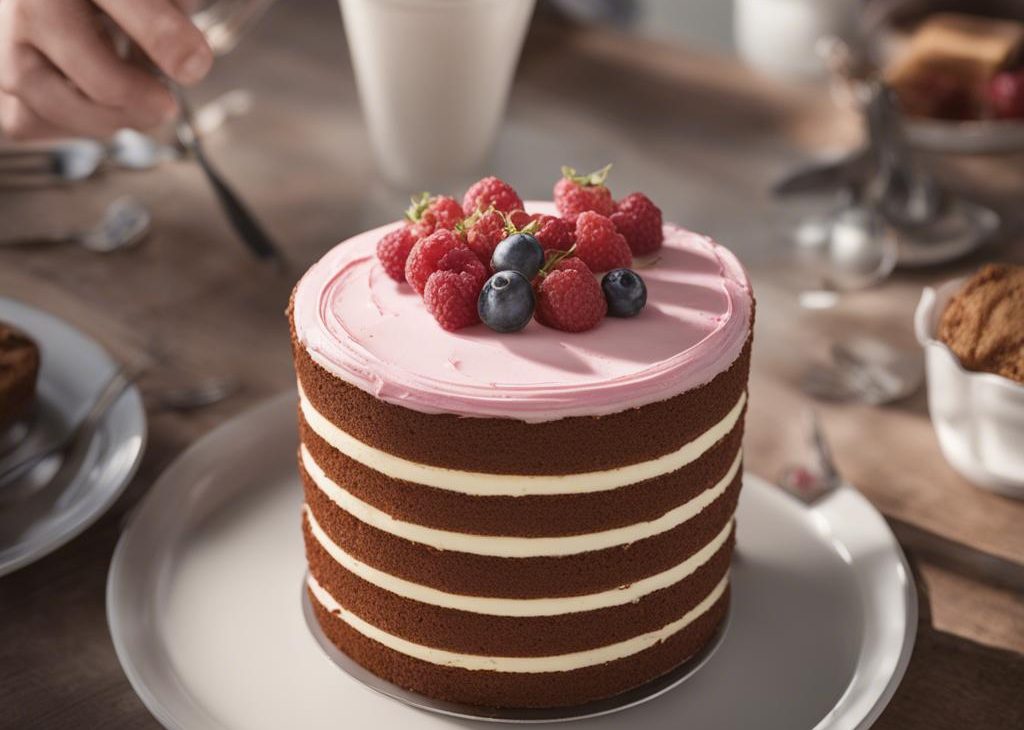


Learn the basics of how to assemble and decorate a layer cake with this detailed post as your guide. I follow the same steps whether I’m making a 2-layer, 3-layer, or 4-layer cake, and whether it’s a 6-inch cake or a 9-inch cake..
I know making layer cakes can seem intimidating, so today I’m helping to make the process a little easier for you. Bookmark this how to assemble a layer cake guide for any time you’re serving a layer cake, whether it’s a 3-layer carrot cake, 2-layer chocolate cake, or smaller 6-inch cake.
Let’s dive right in.
See this post on 10 essential cake baking and decorating tools for more.
It’s important your cake layers are level, so your layer cake has stability. Make sure the cakes are completely cool before you level them. You can use a tool called a cake leveler, but I usually just use a serrated knife. Slice off the domed top so the top is flat. You can discard the bit you sliced off, or crumble it up and use it as garnish on top or around the cake. (Or enjoy the cake crumbles over ice cream—my favorite!)
Decide on the frosting you want to use for your cake. Most of my layer cake recipes include the frosting recipe you’ll need for the cake. American buttercream or Swiss meringue buttercream are my 2 top choices for layer cakes. If using cream cheese frosting, I find it helpful to refrigerate it for at least 1 hour before using, since it isn’t as sturdy and stable as buttercream.
A cake turntable makes it easier to frost the sides. I usually use about 3/4 to 1 cup of frosting between each cake layer. To spread it, use an offset spatula, straight icing spatula, or a regular knife. Spread the frosting all the way to the edges.
Place the second cake layer upside down. This creates a flat base for the top layer to sit on. (If your cake is only 2 layers, you can place the 2nd (top) layer upside down OR right side up.) Check to make sure the cake layer is level all the way around. Then add another 3/4–1 cup of frosting on top, again spreading it to the edges.
Place the top layer on top. You can place it upside down again if you want your cake to have a very straight look on the sides and a perfectly flat top, but I usually place the top layer right-side-up, so that there’s a bit of a curve to the edges.
This is a very thin layer of frosting applied to the top and sides of the cake, which helps lock in any loose crumbs and adds stability to the finished layer cake. It also makes a nice smooth base for frosting and decorating. Use about another cup of frosting (240g) for that. Start moving the frosting from the top down the sides. Go around the sides with a bench scraper—it’s a really handy tool that makes easy work of smoothing out the sides. Refrigerate for 20 minutes to an hour to set the crumb coat.
Once your crumb coat has set, you can finish the cake with a thicker layer of frosting. I recommend a straight spatula for this. You can use your bench scraper again for smooth sides, but I like a little texture.
If you used a cake turntable and want to transfer your cake to a serving platter or cake stand, it’s helpful to have a cake lifter tool and a second set of hands.
If you have extra frosting, you can use a piping bag and tip and add some decoration. Here I used the Wilton 1M tip to pipe a shell border around the top and bottom of the cake.
When it comes to cake decorating, I like to keep things simple. As much as I admire all those cake artists out there and marvel at their creations, I accept that cake artistry is simply not in my skill set! BUT there are ways you can make a beautiful layer cake, even if you lack artistic skill.
Take this rustic-chic naked cake, for example. Garnishing with fresh florals and berries adds simple, sophisticated elegance—no piping tips, fondant, or modeling chocolate required.
A simple garnish of fresh berries and mint is one of my favorite ways to garnish a cake, because it’s so EASY, yet takes the cake to the next level.
You can also garnish with an ingredient used in the cake, such as toasted nuts on top of this carrot cake, or coconut and fresh pineapple on top of this pineapple coconut cake.
Learn the basics of how to assemble and decorate a layer cake with this detailed guide. I follow the same steps whether I'm making a 2-layer, 3-layer, or 4-layer cake, and whether it's a 6-inch cake or a 9-inch cake..